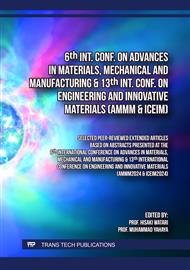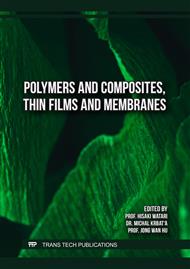[1]
N. Abid, A.M. Khan, S. Shujait, K. Chaudhary, M. Ikram, M. Imran, J. Haider, M. Khan, Q. Khan, M. Maqbool, Synthesis of nanomaterials using various top-down and bottom-up approaches, influencing factors, advantages, and disadvantages: A review, Adv Colloid Interface Sci. 300 (2022) 102597.
DOI: 10.1016/j.cis.2021.102597
Google Scholar
[2]
A. Haider, S. Haider, I.-K. Kang, A comprehensive review summarizing the effect of electrospinning parameters and potential applications of nanofibers in biomedical and biotechnology. Arab. J. Chem. 11(8) (2018) 1165-1188.
DOI: 10.1016/j.arabjc.2015.11.015
Google Scholar
[3]
G.G. Flores-Rojas, B. Gómez-Lazaro, F. López-Saucedo, R. Vera-Graziano, E. Bucio, E. Mendizábal, Electrospun Scaffolds for Tissue Engineering: A Review. Macromol. 3(3) (2023) 524-553.
DOI: 10.3390/macromol3030031
Google Scholar
[4]
V.S. Reddy, Y. Tian, C. Zhang, Z. Ye, K. Roy, A. Chinnappan, S. Ramakrishna, W. Liu, R. Ghosh, A Review on Electrospun Nanofibers Based Advanced Applications: From Health Care to Energy Devices. Polymers (Basel). 13(21) (2021) 3746.
DOI: 10.3390/polym13213746
Google Scholar
[5]
S.-d. Liu, D.-s. Li, Y. Yang, L. Jiang, Fabrication, mechanical properties and failure mechanism of random and aligned nanofiber membrane with different parameters. Nanotechnol. Rev. 8(1) (2019) 218-226.
DOI: 10.1515/ntrev-2019-0020
Google Scholar
[6]
P.G. Chao, Crimped Electrospun Fibers for Tissue Engineering, in: K. Chawla (eds), Biomaterials for Tissue Engineering, Methods. Mol. Biol., Humana Press, New York, 2018, pp.151-159.
DOI: 10.1007/978-1-4939-7741-3_12
Google Scholar
[7]
L. Zhang, L. Liu, F. Pan, D. Wang, Z. Pan, Effects of Heat Treatment on the Morphology and Performance of PSU Electrospun Nanofibrous Membranes. J. Eng. Fibers Fabr. (2012) 7.
DOI: 10.1177/155892501200702s02
Google Scholar
[8]
T. Nuge, K.Y. Tshai, S.S. Lim, N. Nordin, M.E. Hoque, Preparation and Characterization of Cu-, Fe-, Ag-, Zn- and Ni- Doped Gelatin Nanofibers for Possible Applications in Antibacterial Nanomedicine. J. Eng. Sci. Technol. 12 (2017) 68-81.
Google Scholar
[9]
R. Huang, Y. Zhang, A. Xiang, S. Ma, H. Tian, Y, Ouyang, A. Varada Rajulu, Crystallization behavior of polyvinyl alcohol with inorganic nucleating agent talc and regulation mechanism analysis. J. Polym. Environ. 30(8) (2022) 3163-3173.
DOI: 10.1007/s10924-022-02408-2
Google Scholar
[10]
Y. Liang, S. Cheng, J. Zhao, C. Zhang, S. Sun, N. Zhou, Y. Qiu, X. Zhang, Heat treatment of electrospun Polyvinylidene fluoride fibrous membrane separators for rechargeable lithium-ion batteries. J. Power Sourc. 240 (2013) 204-211.
DOI: 10.1016/j.jpowsour.2013.04.019
Google Scholar
[11]
J.V. Sanchaniya, I. Lasenko, S.P. Kanukuntala, H. Smogor, A. Viluma-Gudmona, A. Krasnikovs, I. Tipans, V. Gobins, Mechanical and Thermal Characterization of Annealed Oriented PAN Nanofibers. Polymers (Basel), 15(15) (2023) 3287.
DOI: 10.3390/polym15153287
Google Scholar
[12]
H. Palak, E. Güler, M. Nofar, B. Karagüzel Kayaoğlu, Effects of D-lactide content and molecular weight on the morphological, thermal, and mechanical properties of electrospun nanofiber polylactide mats. Jo. Ind. Text., 51(2_suppl) (2022) 3030S-3056S.
DOI: 10.1177/15280837221090260
Google Scholar



